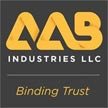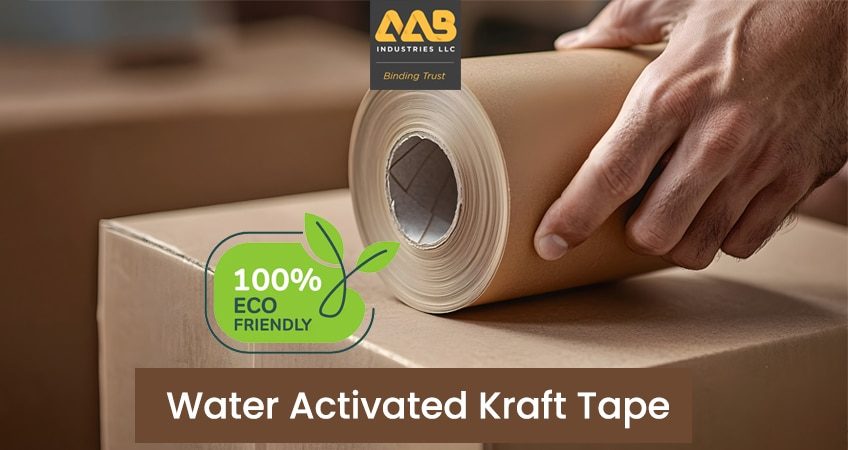Ages ago, paper tapes, or gummed paper tapes, were used to seal and pack materials. These tapes were popular long before plastic tapes were even a concept. Fast forward to today, where plastic tapes dominate the packaging industry, contributing significantly to plastic waste. In response, paper tapes are making a heroic comeback, reminding us of their versatility and environmental benefits.
What is Water-Activated Tape [WAT]?
It is the tape made from kraft paper backed by a water-activated adhesive. Unlike regular plastic tape, it doesn’t stick automatically upon application. Instead, WAT requires a small amount of water to activate the glue before it can be applied to any surface. For added tensile strength, the tape often includes reinforced threads.
Invention and History
According to historical records, water-activated tape was first used in the late 19th century. Specifically, it was produced in the 1870s for sealing and packaging packages and documents. Here is a timeline of its invention and evolution:
Invention
With the growing need for packing and sealing couriers and packages, water-activated tape was invented. It was an effective, easy and economical way of sealing.
Evolution
Later, when manufacturers sensed the demand for stronger sealing tape, they introduced reinforced water-activated tape. Such tape contains a continuous thread layer that adds strength to the tape.
Current Usage
By the early 20th century, water-activated tape had become a standard in the shipping and packaging industry, especially for companies that required tamper-evident seals.
Since its invention, WAT has continued to be a trusted choice for secure and environmentally friendly packaging solutions.
How Is Water Activated Tape Manufactured?
As it was one of the primitive methods of sealing, WAT doesn’t require complicated production processes. It requires some basic ingredients like:
- Kraft paper as the base of the WAT. It must be tear-resistant, hence the quality of the kraft tape must be checked before using
- Fiberglass strands of threads are also used for additional strength. However, this is an optional step in the process.
- Animal or starch-based adhesive is used which activates after reacting with water.
- In the case of printed water-activated tapes, ink is used.
Manufacturing Process
- The first step involves choosing suitable kraft paper. In the case of reinforcement, fiberglass threads are added to the kraft paper at this stage.
- The second stage involves adding or laminating one side of the kraft paper with water-activated adhesive. The liquid state of the adhesive helps it even coat across the kraft paper surface.
- The coated kraft paper is passed through drying chambers to dry the liquid glue. This solidifies the adhesive. However, the adhesive remains inactive until water is used to activate it. It is then it is wound onto the core.
- Upon drying the adhesive, the kraft tape is cut into the desired width and length and then packed into boxes.
- In the case of branding or printed tapes, inks or printing dyes are applied to the tape once wound onto the core. Then it is cut and packed.
Physical Features of Water Activated Kraft Tape
What differentiates water-activated kraft tape from others are its unique physical properties. Here are the most unique features of WAT:
-
Activatable Adhesive
This is One of the most unique features of the water-activated kraft tape is its activatable adhesive. To activate the adhesive, use a small amount of water and then apply tape on the surface you want to seal or pack.
-
Eco-friendly Material
This tape features kraft paper that is eco-friendly and leaves no carbon footprint once disposed of.
-
Strength
Though kraft paper adds strength to the water-activated kraft tape, the incorporation of fiberglass threads into this tape adds extra tensile strength and makes it seal-proof.
Benefits of Water Activated Kraft Tape
To answer this question, let’s discuss the benefits of water-activated tape.
-
Eco-friendly
Kraft paper makes water-activated tape adhesive tape eco-friendly and compostable.
-
Tamper-Evident
It is designed to be tamper-resistant. So it is difficult to remove this tape without damaging the packaging, hence it shows a sign of tampering has occurred.
-
Versatile
It can be used on a variety of surfaces and is particularly effective on corrugated cardboard and similar materials.
What Is Water Activated Adhesive Tape Used For?
WAT is ideal for a wide range of applications mainly sealing, packing, and long-term storage. It does not lose its adhesion even for long periods, and due to this fact it is widely used in shipping, moving and courier companies as well. It is a reliable, eco-friendly option for secure packaging needs.
How Do You Activate Water Activated Tape?
- Clean the surface you are sealing.
- Cut water-activated kraft tape to the desired length.
- Apply an adequate amount of water on the adhesive side of the tape – You can use a sponge, brush or even water-activated tape dispensers for this.
- Paste the tape on the required surface ensuring the adhesive side is down and press it firmly.
- Use any tool or hands to remove any air bubbles between the tape and the surface.
- Let the tape dry completely for some minutes.
FAQ
Is Water-Activated Tape Strong?
Reinforced water-activated tape is stronger than normal plastic tape. The fibreglass threads add extra strength to the water-activated adhesive tape.
Is Water Activated Tape Worth It?
It is worth buying due to its bonding properties, ecofriendliness and easy application.
Is Paper Tape Waterproof?
Water-activated kraft tape is not completely waterproof, it is water resistant. It can resist humidity and moisture.
Why Is Water Activated Tape Used?
It is used for sealing, bonding, packing and storing material, parcels, couriers and boxes.
Is Masking Tape and Paper Tape the Same?
Though masking tape is made of paper-based material, the material used in it is crepe paper. On the other side, water-activated tape is made of kraft tape that is water-resistant, tamper-evident and tensile.


